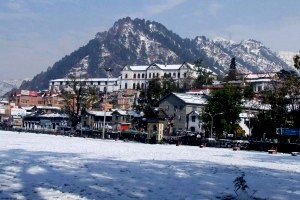Chamba valley, perhaps the loveliest in Himachal, is known for its scenic attractions, sparkling streams, lakes, meadows and lush deodar forests. Crowned with high mountain ranges, Chamba, rich in wildlife is home to animals like the elusive snow leopard, ibex, brown bear, leopard and the musk deer.
A splendid artistic heritage includes fine temple architecture, beautiful miniature paintings and exquisite embroidered Chamba Rumals. Chamba’s serene beauty makes it the ideal holiday retreat.
 Chamba offers a variety of scenic beauty to the tourist. It touches the fringe of the Shivaliks and has the three well-defined snowy ranges, the Dhauladhar constituting the outer Himalayas, the Pir Panjal or the mid-Himalayas and the Zanskar range or the inner Himalayas. The river Raviassociated with melodic folk songs flows at the feet of Chamba town. Its cultural heritage, an iota of it displayed in Bhuri Singh Museum, its dances, Dandaras and Ghurai, its folk songs, its miniature paintings, its ‘Rumal‘ said to be painting done in embroidery, its ‘chukh‘ – a pickle of chillies – and its ‘chappals‘ – all have that special Chamba appeal. Dalhousie, a tiny town, with the colonial charm and modernity contrasts with the ancient traditions and folkish lives of the people in the rest of Chamba but the natural ambience of the District merges the two well. The Ravi river flows through this district, and many hydroelectric generating stations have been developed here.
Chamba offers a variety of scenic beauty to the tourist. It touches the fringe of the Shivaliks and has the three well-defined snowy ranges, the Dhauladhar constituting the outer Himalayas, the Pir Panjal or the mid-Himalayas and the Zanskar range or the inner Himalayas. The river Raviassociated with melodic folk songs flows at the feet of Chamba town. Its cultural heritage, an iota of it displayed in Bhuri Singh Museum, its dances, Dandaras and Ghurai, its folk songs, its miniature paintings, its ‘Rumal‘ said to be painting done in embroidery, its ‘chukh‘ – a pickle of chillies – and its ‘chappals‘ – all have that special Chamba appeal. Dalhousie, a tiny town, with the colonial charm and modernity contrasts with the ancient traditions and folkish lives of the people in the rest of Chamba but the natural ambience of the District merges the two well. The Ravi river flows through this district, and many hydroelectric generating stations have been developed here.
Chamba district is in the northwest of Himachal Pradesh, with its headquarters in Chamba town. Chamba is Ancient Capital of Pahari Kings situated on the bank of river Ravi at an altitude of 996 meters. Chamba was founded in 920 AD after capital was shifted from Bharmour, King Sahil Verma who named it after his favourite daughter Champavati. Surrounded by higher ranges Chamba is known for the elegence of its temples and handicrafts. In the centre of the town there is a spacious playgroung called the Chowgan, a grassy maidan, about 805 metres in length and 73 metres wide, where people gather for a social, political or religous meetings or a sports event. Regular buses link Chamba with Dalhousie and Pathankot. Chamba is 56 km (via Banikhet), on the right bank of the Ravi at an altitude of 915 metres (3,000 ft) from Dalhousie and 122 km from Pathankot. There is also a 30 km long-foot path from Dalhousie to Chamba via Khajjiar which passes through thick deodar forests. Chamba lies in the bloosom of the Himalayas. Chamba has preserved the anchent cultural heritage and civilization. The conservative character of the people haas tended to perpetuate the existing social customs and conditions. Still, there are old tribes i.e. Caddies and Pangwalas. For geographical reasons their customs, culture and habits differ from the people of the rest of the district. Chamba’s hills and mountains, rivers, lakes, springs and streams, green meadows and forests are of matchless charm.
Among the most interesting objects in Chamba are a number of richly carved ancient temples which closely resemble those in Rajasthan. The most striking of these are the six temples lying in a row near the palace. Three of these are dedicated to Vishnu and the remaining to Siva. All the shrines have shikharas or spires which distinguish them from other hill temples that are usually pent-roofed. Some of the temples date back to the tenth century. The richly carved Laxmi Narayan temple is the oldest one. Chamba is the starting point for many of the treks into the interior of the hills. A road branches off from here to Kashmir via Bhaderwah, and another to Pangi valley over the Sach Pass. The towns of Dalhousie and Khajjiar are popular hill stations and vacation spots for the people from the plains of northern India. The jungles around Dalhousie and Chamba abound in wild life. In the higher regions near the snow line are to be found,snow leopard, ibex and marmot. At th lower elevations brown bear,musk deer, leopards and wild pigs are seen. Pheasants, partridges and wild fowl are found in all parts of the valley.